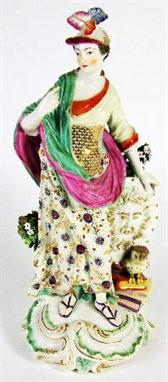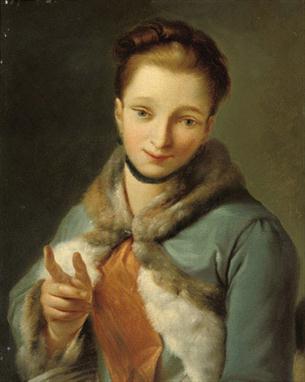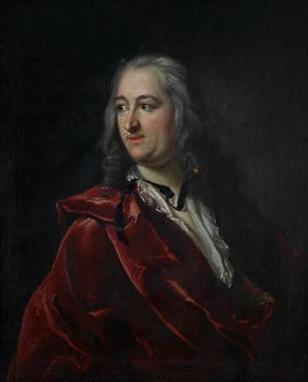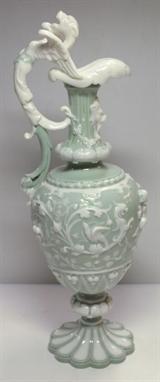Assorted Victorian Costume including a black silk fitted bodice with sequin and bead decoration and white lace collar and cuffs; black satin fitted bodice with black lace and velvet appliques; black satin skirt with pleated and button detailing to the hem; black satin cloak with black lace and braid appliques and beading to the shoulders; black silk and lace trimmed parasol on an ebonised handle (5).
We found 7199 price guide item(s) matching your search
There are 7199 lots that match your search criteria. Subscribe now to get instant access to the full price guide service.
Click here to subscribe- List
- Grid
-
7199 item(s)/page
A pair of Royal Dux Figures of young man wearing wide-brimmed hat and with his cloak over his right arm, and a girl wearing a mop cap and with a jug in her left hand, painted in typical blush colours, each with incised puce triangle marks and also with impressed numbers 1170 and 1171, both 17” high (2)
John Faed (1820-1902) Kinmont Willie Oil on canvas Signed lower right 97 x 120cm (381/4x 471/4in) Provenance Listed by John Faed as sold in 1865 for £500 to Flatou; Lord Courthope, Whiligh, Wadhurst, East Sussex; thence by descent. Exhibited London, The Royal Academy, 1865, No. 536 as Kinmont Willie, a prisoner. “They band his legs beneath the steed, etc.”, See MacEdward Leach, The Ballad Book for The Ballad of Kinmont Willie, William Armstrong of Kinmont, known as Kinmont Willie, was a notorious Border Reiver during the late 16th century. He has been credited with the taking of some 2000 head of Cattle in one raid. In the spring of 1596, a truce day was held near Kershopefoot. It was attended by 200 riders from each of the English Marches as well the Scots with Kinmont Willie in attendance. The two sides settled outstanding matters and compensation was paid for those robbed. Upon completion of this meeting Kinmont Willie headed for home. He was attacked en route by a party of English riders and imprisoned in Carlisle Castle under the care of the English Deputy Warden Salkeld, much to the satisfaction of Lord Scrope, the English warden. Salkeld happened to be the presiding English Officer at the truce meeting earlier that day. Kinmont Willie’s friend and fellow Borderer, Scott of Buccleuch, was enraged at this capture. The “Bauld Buccleuch,” as he is sometimes known, was just 30 and a most daring and reckless young Scottish chieftain. Of course, he was also a renowned Reiver himself and had plenty of grievance with Lord Scrope. Upon hearing of Willie’s capture, he is supposed to have exclaimed, “Now Christ’s curse upon my head, but avenged of Lord Scrope I’ll be.” Buccleuch at first tried all political means to have Willie released until these were all exhausted. He then decided to take matters into his own hands and release Willie by means of a “commando” style raid, he had the Castle studied and found what seemed to be a weakness at the “Postern gate”. He believed that the guards at this post could be overpowered and the gate taken. Scott and 80 handpicked followers including Harden, Will Elliot, Willie “Red Cloak” Bell, Red Rowan and other assorted members of the Elliot’s, Johnson’s and Irvine’s met at Kinmont Willie’s tower, Morton Castle. Willie’s sons were among them. With the way guarded by scouts, they rode in the moonlight in total silence, crossing the River Esk, and completing the 10 mile journey to Carlisle. In addition to arms, they carried ropes, ladders and grappling irons. The need for silence meant the party moved slowly, not arriving until dawn. They overpowered the castle guards, broke through the postern gate, opened Willie’s cell and rushed him out and to horse. In case of a fight, Scott had left the main part of his cavalcade outside the city gates and had planted the Johnsons and Irvines in ambush ready to head off any pursuit. But speed and brilliant planning had done their work and the raiding party was back on Scottish soil by sunrise. The English were left looking inept and Lord Scrope wrote to London, exaggerating the raiding party’s size up to 500 men. Queen Elizabeth was furious and wrote to James VI of Scotland demanding that Scott of Buccleuch be handed over. But James, who approved of the raid, managed to reply with diplomatic vagueness. Lord Scrope raided repeatedly into Scotland in reprisal while Buccleuch and his comrades raided back just as regularly. The situation got so out of control that the Queen demanded of Edinburgh that Buccleuch turn himself in, which he eventually did. He was held in the Tower of London for six months, until his young son was exchanged for him as a hostage. Some years later, when the Bauld Buccleuch traveled to London and into the Queen’s presence, she demanded of him how he had dared to break into her Carlisle stronghold. Buccleuch is said to have replied, “ What is there a man will not dare?” which seems to have mollified the Queen, because she had a soft spot for such roguish daredevils.
A group of early 20th century Russian and other jewellery Comprising: a Russian Art Nouveau, gold, demantoid garnet, amethyst and transluscent enamel pendant; a Russian demantoid garnet and synthetic ruby brooch; a Russian gold knot brooch; a Russian gold and platinum openwork navette shaped brooch; a pair of gold and seed pearl tennis racket cufflinks; a pair of Russian gold and guilloché enamel cloak buttons; a Russian gold pencil holder; a diamond five stone bar brooch; a gold, ruby and enamel flower brooch; a French gold and plique-à-jour enamel circular pendant representing a stained glass window; and a nephrite jade and rock crystal bead bracelet (13) View on Christie's.com
Rembrandt Harmensz. van Rijn (1606-1669) A Small Collection including Christ at Emmaus (Bartsch 87), Man in Cloak and Fur Cap, leaning against a Bank (B. 151), The Persian (B. 152), Old Beggar Woman with a Gourd (B. 168), Beggar with a wooden Leg (B. 179), on various papers and sizes, all glue down to the corners, foxing; together with a later impression of Adriaen van Ostade, Dance under the Trellis (B., G. 47), unexamined out of the frame P. 207 x 160 mm., S. 222 x 170 mm. and smaller (6) View on Christie's.com
AN EXCEPTIONAL ICON OF THE GREAT MARTYR GEORGE "THE VICTORIOUS" MOSCOW, WORKSHOP OF MSTERA MASTER O.S.CHIRIKOV (?), END OF THE 19TH TO BEGINNING OF THE 20TH CENTURY WITH A METAL HALO 35 by 26.5 cm. "The icon is a shining example of the professional icon painting of Mstera. The inscription that appears in the upper border is: "THE HOLY GREAT MARTYR AND BRINGER OF VICTORY GEORGE". The great martyr George is depicted standing against a detailed landscape background; the fingers of his right hand forms the sign of the cross and he holds an eight-armed cross, in the crook of his left arm is a thin spear with a white pennant inscribed with the monogram of Christ; with the same arm he holds a shield. These attributes point to a direct connection between the icon and the milieu of the Old Belief, not only when one pursues the line of the artist (the majority of icon painters from Mstera, including such well known names as M.I. Dikarev and O.S. Chirikov, were Old Believers), but also on the patron’s side. Such depictions of saints — making the sign of benediction and with an eight- armed cross — were banned by the Great Synod of Moscow in 1667 and preserved only amongst the Old Believers. The edge of the upper border of the icon is three-lobed, with the top of the middle lobe ending in the shape of an up- turned keel. The figure of the holy warrior is skilfully painted into this complex shape, implying that the composition was thought through at the outset. The icon has refined colouring: it is executed in bluish and ochre tones and the repeated use of these colours and tints over the entire surface of the icon unifies the figure and the landscape into a single entity. The gold chamfer surrounding the picture itself is perceived as a narrow gilded frame and the painting is distinguished by the fine miniaturism so characteristic of the Mstera school, whose well-known masters possessed astonishing skill. St. George’s rich armour is finely painted: the chased rendering of the corselet, the gorget, wristbands and skirt of the tunic, the little icon of a Guardian Angel on the breast and the clasp fastening the cloak — are all decorated with precious stones and strings of pearls. The rock ledges, the turbulent torrent and the clumps of trees that make up the background are all skilfully painted and the emphasis on the landscape is a brilliant distinguishing feature and an important conceptual and decorative part of the icon. The features we have noted of "St. George the Victorious" mean that it must bear comparison with the work of the greatest masters of this school, Mikhail Ivanovich Dikarev and Osip Semyonovich Chirikov. From 1884-1903, Dikarev and Chirikov worked together on an extensive menological series of icons for the Chapel of the Presentation of the Virgin at the Grand-Ducal Marble Palace in St Petersburg (376 icons). The landscape painting in the menological series was unusually fine and constructed using the rules of perspective. The low horizon emphasised the grandeur of the saint’s figure; the beauty of the landscape (often incorporating churches, monasteries, and panoramas of cities) would be called upon to show the beauty and harmony of God’s creation. All these special characteristics apply fully to our "St. George the Victorious" icon, which means it can be legitimately linked with the aforementioned masters or their workshops. Art historians have drawn attention to the fact that the works of Dikarev and Chirikov are marked by a common style. It seems therefore, there are good grounds why this icon should be attributed if not to Chirikov himself (the icon does not have the artist’s signature on it), then to his workshop. The historic artefacts from the menological series now kept in the State Hermitage, the State Russian Museum and the State Museum of the History of Religion, allow a difference to be discerned in the way landscape is depicted in the icons of Dikarev as opposed to those of Chirikov. The influence of academic painting and the rules of perspective are more noticeable in the works of the former of these two masters. The manner of Chirikov is dominated by traditional methods of icon painting: the horizon on his icons is, as a rule, higher and the landscape is more conventional and fragmented, always incorporating rock ledges and hillocks, and clumps of trees. It is precisely these special features that predominate in the landscape of our "St. George the Victorious" icon. Thus, the particular features of the design, composition and artistic style of the "St. George the Victorious" icon indicate that it was commissioned under a special individual order and represents a unique example of late 19th to early 20th century icon painting of Mstera. It is likely that this image, full of deep inner meaning and expression, and distinguished by the refinement of the colours and restrained ornamentation, was made in the Moscow workshop of the famous icon painter from Mstera, Osip Semyonovich Chirikov."
A LUSTRE WARE BUST OF DAVID GARRICK the actor in a loose claret and brown coat with frilled light green shirt and red cloak, on purple resist socle with a band of palmettes, 19.5cm h, collector`s label, c1820 Provenance: Folkard Collection. ++In good condition with minute spot of flaking on the red cloak and also several tiny glaze scratches, no restoration
A CREAMWARE MODEL OF A RECUMBENT RAM, AN EARTHENWARE DEER SPILL-HOLDER AND TWO MINIATURE FIGURES, STAFFORDSHIRE AND SCOTTISH the first decorated in coloured glazes, the spill holder sponged in black and ochre before a forked tree on deep green mound, the figures of a lady as Ceres and a soldier in forage cap, blue tunic and pink cloak, 10-14.5cm h, c1780-c1860 ++The ram bears an old label inscribed EX GARNER COLLECTION, with two ascending hairline cracks in the back and a large chip on the inner surface of the hollow base. Figure of Ceres - restoration to the sheaf of corn
A late 18th century Enoch Wood figure of an orator, possibly Demosthenes, the bearded man wears a purple lined green cloak as he talks standing by a plinth moulded in relief with Mercury flying above a figure speaking on a sea cliff with two war ships in the distance, E Wood impressed, 47.5cm (18.75in) high This figure has sometime been called St Paul and Eloquence
†† Circle of John Vanderbank (British, 1694-1739) Portrait of Mrs James Hoste of South Wootton and Sandringham nee Hamond (1710-1759) in a Blue Dress and Gold Cloak, three quarter length oil on canvas 125 x 100cm (48.75 x 39in) Literature: Portraits in Norfolk Houses, Prince Frederick Duleep Singh, published 1927, No.36 Susan was the daughter of Antony Hamond and Susan Walpole, and was sister to Robert, 1st Earl of Orford. She married Major James Hoste (1705-44) of Sandringham and had two daughters. At one stage the Hoste family owned the Sandringham Estate in Norfolk, one of Nelson`s Captains at Trafalgar was a Hoste
A Copeland parian figure of Egeria, after John Henry Foley, circa 1860, the classical maiden modelled standing, a loosely draped cloak around her waist, holding her curled hair in her right hand and resting against a tree stump, raised on a canted square base, titled Egeria and impressed `Copeland E I`, 58cm high A very similar figure is illustrated in Copeland (Robert): Parian Copeland`s Statuary Porcelain, S45, pg.138. Foley sculptured the original marble statue for The Mansion House in London in 1855, as one of sixteen literary subjects commissioned from contemporary sculptors. They were exhibited at the Royal Academy in 1856. In Roman mythology Egeria was one of the four prophetic divinities known as the Camenae; fountain nymphs belonging to the religion of ancient Italy. Egeria lived beside her fountain which was situated between the old Appian Way and the road to Naples. She was a protector of women in child birth.
A Pair of Rockingham Porcelain Models of Turks, circa 1830, he standing in turban and flowing burgundy cloak, she with puce cap and blue flowing cloak, each on gilt scroll bases, impressed ROCKINGHAM WORKS, incised numbers and painted CL2 and CL3 in red marks, 8cm and 7.5cm high See Cox (Alwyn & Angela) Rockingham 1745-1842, pl.129.
19TH CENTURY ENGLISH SCHOOL Head and shoulders portrait of a young man wearing white collar and blue tie with brown cloak, inscribed to label verso `To my darling Dora with very best love - Eugenie Kieffer Oct 1880`, 3" x 2"; and one further portrait miniature - `Elizabeth.... nee Sproat of Bormers`, 3 1/4" x 2 1/2" oval (2).
A DRESS UNIFORM "HIGH SHERRIFF OF WARWICKSHIRE, SIR GEOFFREY BIRD" of Bird`s Custard, 1931, comprising photograph, Jacket with marcasite buttons, velvet hat, breeches, velvet waistcoat, cloak, two pairs of silk stockings, three pairs cashmere stockin gs, a pair of white kid gloves, a white silk tie, a white pique tie, a pair of patent leather buckle shoes, a pair of garters, a black kid sword belt, all contained within a steel trunk, with key
A set of four Derby Patch Mark figures, Allegorical of the Seasons, Spring, seated scantily draped, wearing a floral chaplet, holding a basket of flowers on his knee and posy in his right hand, Summer, holding a scythe in his left hand and a wheatsheaf in his right; Autumn, with grape chaplet and holding grapes in his right hand and basket on his knee, Winter, warming his hands on a brazier and wearing a fur cloak, pierced shell and scroll bases, approx 18cm high, c.1770
A 17th Century Spanish Polychromed Pine Carving of Saint Christopher depicted with curly dark hair & beard holding a staff and carrying upon his shoulder the naked Christ Child with orb. Saint Christopher wearing a flowing cloak over a belted tunic enriched with fine gilt embellishments and having a reliquary inset to the skirt. Standing on a square plinth base 26 is (66 cms) in height.*
-
7199 item(s)/page
















































